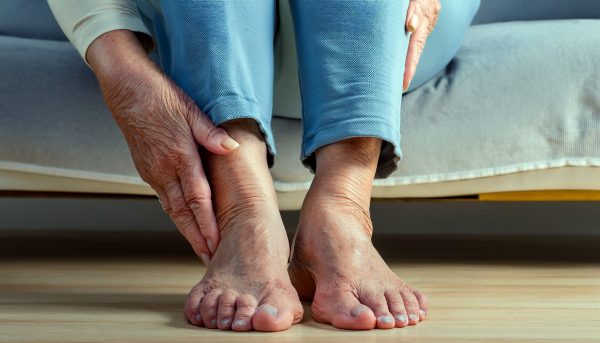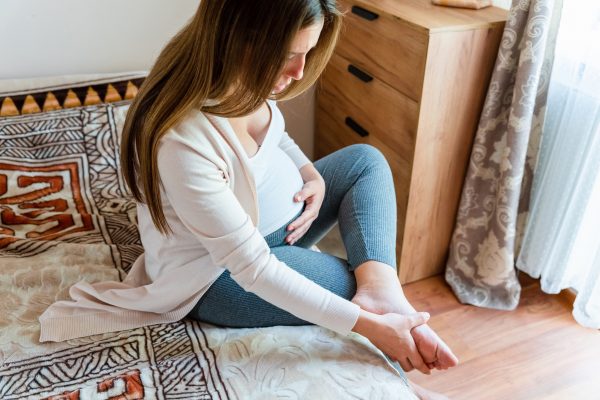We’ve all been there — it’s the end of a long day, and suddenly your shoes feel two sizes too small. Swollen feet and ankles can be uncomfortable, frustrating, and sometimes even alarming. While it’s often nothing more than your body’s response to standing, sitting, or heat, swelling can also be an early warning sign of something more serious.
Let’s take a look at the common causes of swollen feet and ankles, the red flags you shouldn’t ignore, and how a podiatrist can help you get the answers you need.

What Causes Swollen Feet and Ankles?
Not all swelling points to something serious. Many causes are linked to everyday habits, temporary changes in your body, or minor injuries.

Lifestyle and Environment
Sometimes swelling is just your body’s way of saying, “I need a break.” Long hours on your feet, sitting at a desk, or even Florida’s heat and humidity can all cause temporary fluid buildup. A high-sodium diet can also lead to swelling by causing your body to retain water.
Simple changes can sometimes help. For example, gentle movement or even occasional barefoot walking can improve circulation, one of the lesser-known benefits of going barefoot.
💡 Tip: If your swelling improves after elevating your feet or reducing salt intake, it’s usually not a cause for concern.
Medications and Life Stages
Certain medications — like blood pressure drugs, hormones, or steroids — list swelling as a side effect. Pregnancy is another common cause. Many women experience swollen ankles and feet in later trimesters due to increased fluid and pressure on the veins.
💡 Tip: If you suspect your medication is causing swelling, never stop taking it on your own. Discuss alternatives or adjustments with your prescribing doctor.
Minor Injuries
A sprain, fracture, or even stubbing your toe can lead to swelling as part of your body’s natural healing response. With injuries, swelling is typically localized and often accompanied by pain or bruising.
While most swelling comes from common injuries, there are also rare foot conditions that can affect circulation or bone health and cause swelling, though these are far less frequent.
💡 Tip: If swelling from an injury doesn’t improve within a couple of days — or gets worse — it’s best to have your foot or ankle evaluated by a podiatrist or urgent care provider.
When Should I Worry About Swollen Feet and Ankles?
This type of long-lasting swelling is known as edema, a medical term for fluid buildup in tissues. Edema can affect the feet and ankles when circulation or fluid regulation is impaired.
Most swelling goes away once you rest, elevate your legs, or cool down. But sometimes, swollen feet and ankles are a sign of a more serious condition. Knowing the red flags can help you decide when it’s time to call a doctor right away.

Signs That Your Swelling Is Serious
Seek immediate medical attention if you notice:
- Swelling in only one foot or leg
- Shortness of breath or chest pain along with swelling
- Redness, warmth, or tenderness (possible infection or blood clot)
- A sudden, dramatic increase in swelling
These symptoms may point to urgent health issues that require prompt attention. If you notice these signs, don’t wait — seek care right away.
Chronic Medical Conditions
Sometimes swelling builds gradually and sticks around. In these cases, it may be a sign of a chronic condition that requires medical attention.
Venous insufficiency is one of the most common culprits. When the veins in your legs don’t move blood as effectively as they should, fluid can pool in the feet and ankles, leading to persistent swelling.
Persistent swelling can sometimes overlap with circulation problems such as peripheral artery disease, a condition where narrowed arteries reduce blood flow to your legs and feet.
💡 Tip: Compression stockings or elevating your legs may ease discomfort, but only a specialist can determine whether vein health is the root cause.
Heart, kidney, or liver disease can also cause circulation problems, making it harder for your body to move or balance fluids. This imbalance often shows up as swelling in the lower legs, feet, or ankles.
💡 Tip: If swelling comes with fatigue, shortness of breath, or unexpected weight gain, it’s important to get checked promptly so the right treatment can begin.
The Right Next Step: The Podiatrist’s Role in Diagnosis

How a Podiatrist Can Help
Because swelling often begins in the feet and ankles, a podiatrist is usually the first specialist who can tell whether it’s a minor issue or a sign of something more serious.
At Foot and Ankle Group in Bonita Springs, Cape Coral, and Ft. Myers, podiatrists use in-office tools such as vascular testing (tests that measure blood flow in the legs) to check for circulation problems. This helps identify the true cause of swelling—whether it’s related to lifestyle, injury, or a medical condition.
Your Path to an Answer
Does swelling go away on its own? Sometimes swelling from heat or long days on your feet will fade with rest. But if swelling is linked to an underlying issue, it won’t resolve without treatment.
A podiatrist can give you a clear diagnosis and a personalized plan. That may include:
- Lifestyle adjustments (like footwear changes or activity modifications)
- Medications to reduce swelling or improve circulation
- Referral to another specialist if heart, kidney, or liver disease is suspected
The key is knowing what you’re dealing with, and that starts with a professional exam.
Don’t Guess, Get an Answer: Find Out What’s Causing Your Symptoms
Swollen feet and ankles can be caused by something as simple as heat or as complex as heart disease. The only way to know for sure is to get a professional evaluation.

Don’t try to self-diagnose, and don’t wait for the swelling to “just go away.” For peace of mind, schedule an appointment with Foot and Ankle Group today.
Categorized in: Blog
Comments are closed